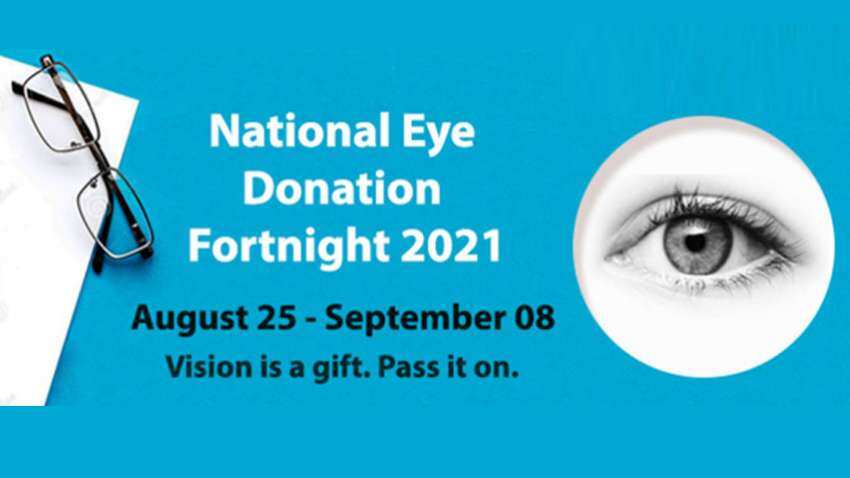National Eye Donation Fortnight: Myths and Facts around Eye Donation
National Eye Donation Fortnight: The objective is to create awareness about the importance of eye donation and to motivate people to pledge their eyes for donation after death.

National Eye Donation Fortnight is observed from August 25 to September 8. The objective is to create awareness about the importance of eye donation and to motivate people to pledge their eyes for donation after death. According to the National Health Portal of India, blindness is one of the major public health problems in developing countries. It said that approximately 68 lakh people suffer from corneal blindness in at least one eye and out of these, 10 lakh are blind in both eyes in the country.
According to World Health Organisation (WHO), corneal diseases are among the major causes of vision loss and blindness after cataract and glaucoma. Approximately 5% of the world’s population is blind due to corneal diseases alone. Corneal diseases damage the tissue covering the front of the eye called the cornea.
It is important to understand that each pair of donated eyes can restore vision in two persons. Besides, eye donation is also considered to be a noble cause and people shouldn’t lose out on the opportunity to help those who need it the most. However, there are plenty of myths associated with eye donation that demotivates people to come forward and pledge their eyes for donation. A lot needs to be done to spread awareness regarding eye donation so that burden of blindness can be reduced.
Let’s have a look at some of the common myths associated with eye donation:
#1 Myth: Aged or older people cannot donate their eyes
Reality: People of any age group can be eye donors. The lower age limit to donate eyes is 1 year, and anyone above that age can donate their eyes. Age is not a restriction towards eye donation.
#2 Myth: People with a history of eye disease cannot donate their eyes
Reality: Those who use spectacles for long sightedness, short-sightedness or astigmatism or even those operated for cataracts or glaucoma can still donate their eyes, as these conditions may not affect the cornea.
#3 Myth: Eyes can be donated any time after death
Reality: It is important to remember that eyes can only be donated six hours after death. However, the body of the deceased person must be kept in a cold environment. Patients with rabies, HIV, septicaemia, etc. cannot donate their eyes even after death.
#4 Myth: Eye donation will lead to facial disfigurement
Reality: The donation of eyes does not cause any sort of disfigurement of the face. Instead of the entire eye, the cornea is removed.
Supporting the government's National Eye Donation Fortnight, ENTOD Pharmaceuticals (an India-born international research-based pharmaceutical company) is organising a campaign to create awareness regarding the importance of eye donation. Under the #pledgemyeyes initiative, ENTOD Pharmaceuticals aims to reach out to more than 20 million people across the country.
Nikkhil K Masurkar, CEO, ENTOD Pharmaceuticals, said that aim is to highlight that the barriers to eye donation are mostly due to misinformation and apprehensions about the proper utilisation of the donated tissue.
"There are many misconceptions about different aspects of eye donation. During this nationwide campaign, we will tell people the facts, educate them and encourage them to pledge their eyes," Masurkar said.
“There is a necessity for reasonable awareness concerning eye donation. Awareness of adults can enlighten the community members as well as their relatives and can motivate them for eye donation which in term will enhance the eye donation rates," Padma Shree awardee Professor Dr S Natarajan, founder of Aditya Jyot Eye Hospital, said.
According to ENTOD Pharmaceuticals, there are only 435 functional eye banks (EBs) and eye donation centres (EDCs) in India involved in the collection and distribution of donated eyes as per the National Programme for Control of Blindness (NPCB). This amounts to nearly 1 EB/EDC per 3 million population. A majority of these are concentrated in urban regions.
Also, some of the states are lagging in terms of eye donations. Maharashtra with 74 eye banks — which is 20 per cent of India’s eye banks — has managed 23,311 eye donations from March 2015 to July 2018. During the period, Telangana (two eye banks, 27,725 donations), Tamil Nadu (38 eye banks, 37,898 donations) and Gujarat (29 eye banks, 26,759 donations) have achieved higher targets. Assam only had 158 eye collections in 2017-2018 as compared to 1865 from West Bengal and 1263 from Odisha.
Get Latest Business News, Stock Market Updates and Videos; Check your tax outgo through Income Tax Calculator and save money through our Personal Finance coverage. Check Business Breaking News Live on Zee Business Twitter and Facebook. Subscribe on YouTube.
RECOMMENDED STORIES

Rs 3,500 Monthly SIP for 35 years vs Rs 35,000 Monthly SIP for 16 Years: Which can give you higher corpus in long term? See calculations

Power of Compounding: How long it will take to build Rs 5 crore corpus with Rs 5,000, Rs 10,000 and Rs 15,000 monthly investments?

Small SIP, Big Impact: Rs 1,111 monthly SIP for 40 years, Rs 11,111 for 20 years or Rs 22,222 for 10 years, which do you think works best?

Looking for short term investment ideas? Analysts suggest buying these 2 stocks for potential gain; check targets

SCSS vs FD: Which guaranteed return scheme will give you more quarterly income on Rs 20,00,000 investment?
01:41 PM IST









 Centre for Sight expands its footprint, announces strategic collaboration with Laxmi Eye Hospital in Maharashtra
Centre for Sight expands its footprint, announces strategic collaboration with Laxmi Eye Hospital in Maharashtra World Sight Day 2022: Theme, history, significance and all you need to know
World Sight Day 2022: Theme, history, significance and all you need to know